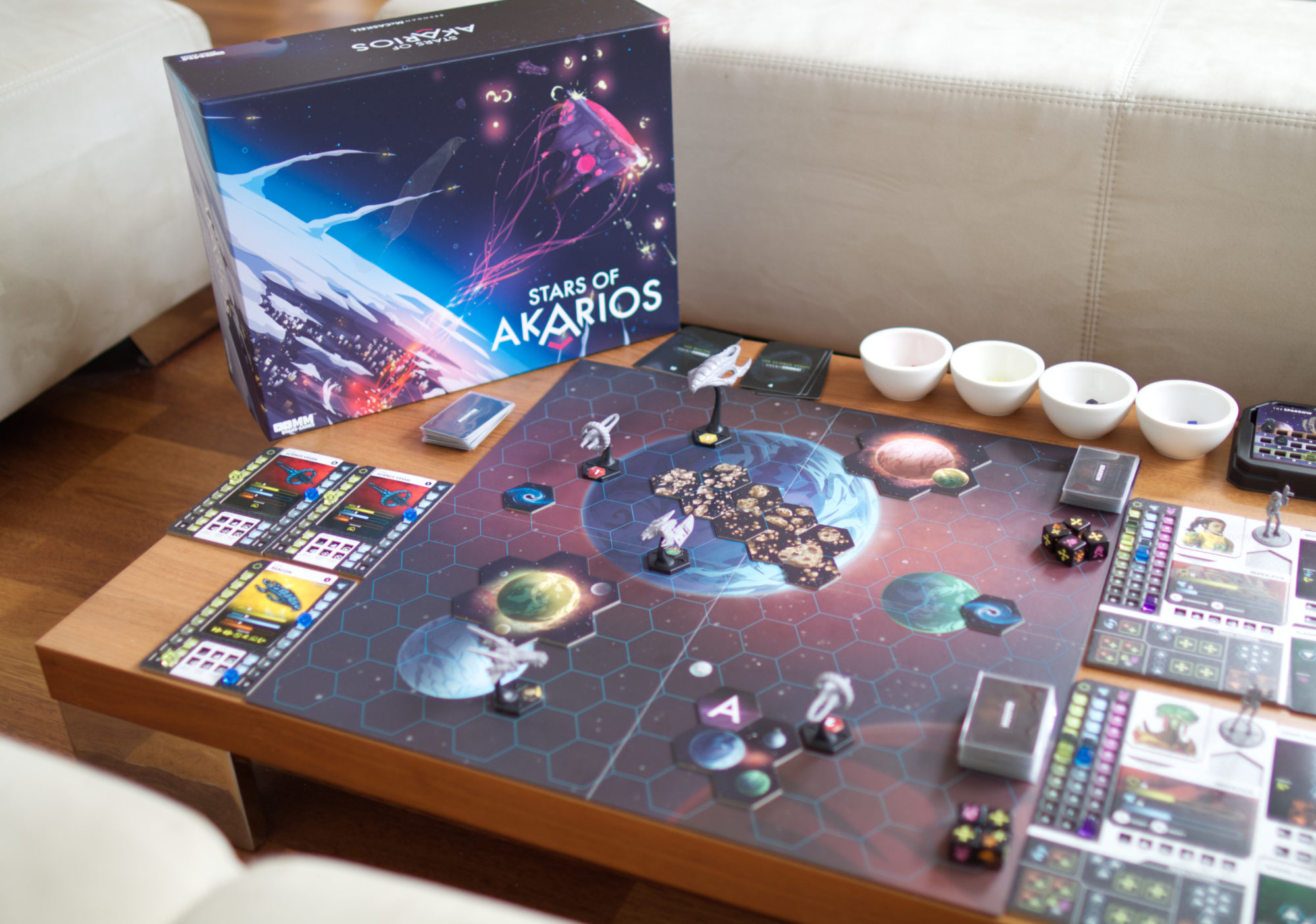I was just thinking I might be the least qualified person on BGG to write about Stars of Akarios: I have played neither Gloomhaven, Tainted Grail: The Fall of Avalon, nor Star Wars: X-Wing Miniatures Game, so a lot of comparisons others make I cannot draw from. I’m also not a miniature-driven purchaser of games. But for some reason, when I heard of Stars of Akarios, I was really drawn to it. Maybe it’s those fond memories of watching the modern Battlestar Galactica reboot or playing way too many hours of the PC game Wing Commander back in the days. Stars of Akarios certainly has a visual allure and I was looking for something with a story that could pull me in, thinking of how much I enjoyed my many, many hours of Sleeping Gods.
So here goes. Here is what I’ve discovered so far, having reached the end of Act 1 playing mostly two-handed solo with one 2 player session in between. I’ll keep this spoiler free and as always rather focus on the feel and general concepts rather than detailed rules discussions.
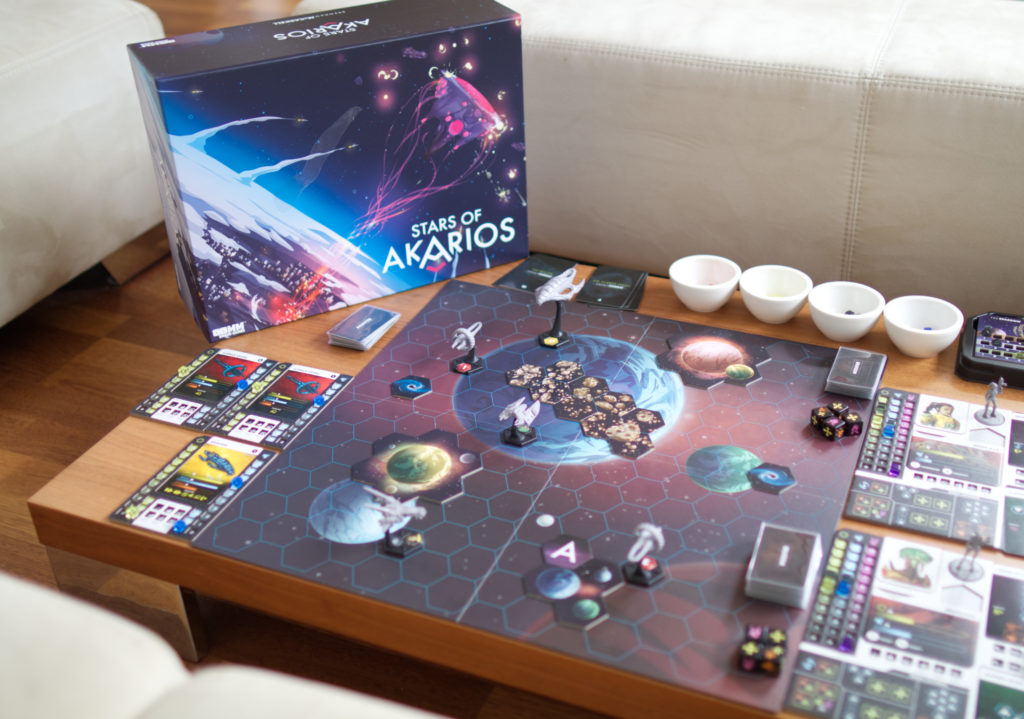
Setup
You’re a crew of fighter pilots among a starship called the Sparrow. Imagine a cross between Battlestar Galactica and flight school. You’re young and inexperienced but inadvertently thrown full into the action when … something … happens. At the beginning of the campaign, each player chooses a starting pilot and ship from a set of 4 each (5 ships if you got the extra “Charis” ship). You also get a nice double layer player board as well as some basic equipment for your ship: a weapon upgrade and engine upgrade that are improvements of the standard move/attack actions and come from a collection of upgrades to choose. In a similar fashion, you can also pick a unique tech for your ship. Put everything into the appropriate slots on the player board, add transparent Pandemic-style cubes as markers, pull off a sheet for your pilot from a block of character sheets, grab 4 of the special action dice as well as a modifier deck (more on that later) and you’re good to go. You are about to embark on a campaign that will keep you busy for quite a number of evenings …
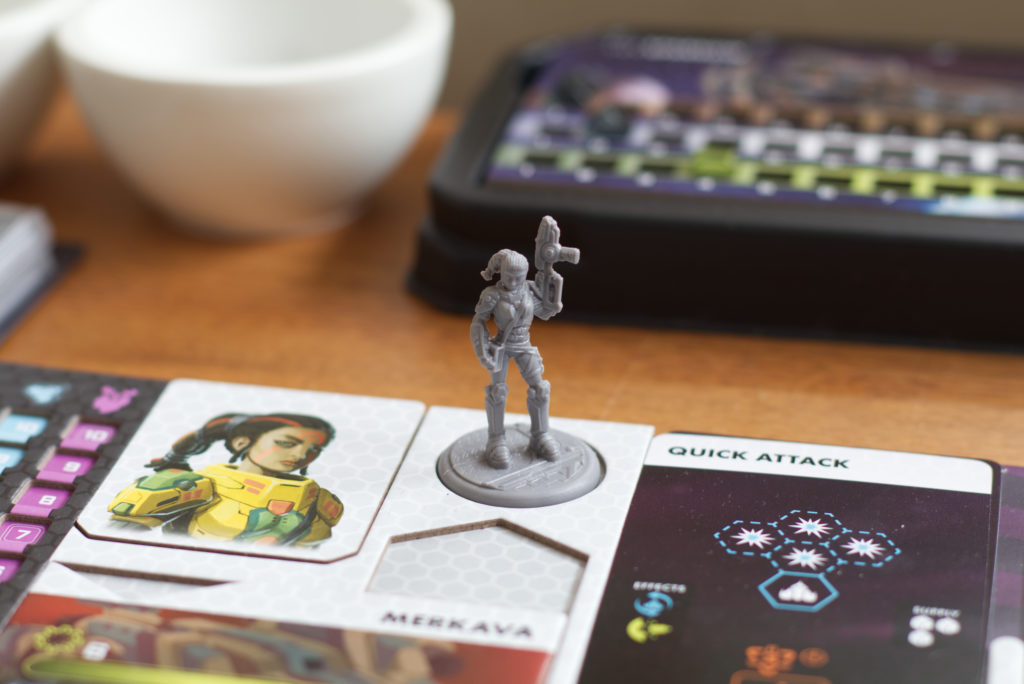
The campaign is structured in four general types of scenarios, all contained in a quite thick scenario book:
- space exploration where you’ll move the Sparrow through one of a handful of star systems
- space combat where you’ll step into your fighter and fight enemies or escort allies (this is by far the biggest portion of the game)
- world exploration where you dock the Sparrow and explore a planet’s surface
- and pure text scenarios that connect other scenarios and offer choices on how you want to proceed in the story
The story throws you straight into combat and the scenario book lets you know which portion of the 40-page rules you need to know to get going. Scenario by scenario, you’ll go through various aspects of the game until you hit the end of the prologue at which time you’ll have learned all the rules of Stars of Akarios. The prologue has intentionally been designed as a rather straight sequence of scenarios with only minor choices/branching. But with the beginning of Act 1, the shackles are off and you’re free to roam. All in all, there are 3 acts plus the prologue. Within an act, you quite often come to the point where you have to make a choice which faction to associated yourself with, to help a stranger or rather play it safe and ignore him, and so on. Those choices are recorded on another sheet of paper and will influence which scenarios you’ll be able to play. I would say act 1 is roughly 15-20 scenarios, depending on how many side quests you choose to follow, with a single space combat being roughly around the 30-45min mark including setup.
Space Exploration
At the highest level, there is space exploration consisting of a deck of tarot-sized cards. The box contains four such decks ranging from 5-20 cards in size. This acts as a slowly revealing map of the area with various interaction points that lead to combat or world exploration scenarios. Characters you talk to will tell you to “scout” a certain scenario number at a certain coordinate in the system (e.g “#039 V-1.3” is scenario 039 on the card 1.3 in the “Vertus” system). If you want to follow that part of the story, move the Sparrow to that sector by spending supplies (the resource of the ship). You can also move to other markers that indicate optional side missions which can be quite dangerous but offer nice upgrades or other rewards.
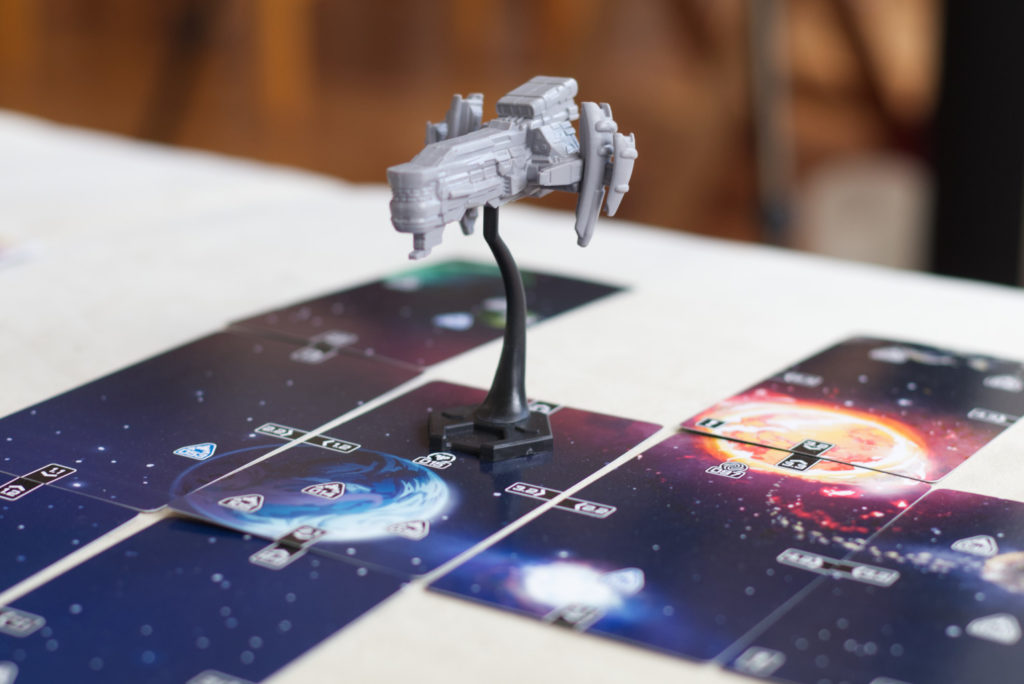
When it comes to space exploration, don’t think of something like Sleeping Gods. Most locations seem locked until you reach the correct time in the story. So it’s more a mechanism to convey the story rather than a sandbox to explore. On some cards, random events such an astroid field can happen while you are moving through the star system. But that’s about it. Space exploration is mostly an interlude between other scenarios and there to convey the scope of things rather than have any essential game mechanisms.
Space Combat
This is the core of Stars of Akarios. A scenario typically consists of a small piece of story telling, a setup guide in the form of a map illustration, and a success/failure section containing a bit more story and potential rewards. Depending on the mission, there can also be special rules that apply (e.g. automatically moving ships that you have to protect). So starting a combat scenario consists of grabbing various cardboard pieces and ships from the box and placing them on the game board. This scales depending on the number of players. More players, more enemies on the map. In the box you’ll find planets (impassable), nebula and astroid fields (penalties when moving through them), scenario location markers and so on. While there is variation in the artwork, there are not as many functionally different elements in the box as you might think. The highlight are of course the various classes of enemy ships, cardboard standees in the base game or plastic miniatures when you purchase the optional “Ships of Akarios” box. Each ship has a hull value, shield value and base fire power. Strike an enemy and you first just reduce its shields. Once all shields are gone, any excess damage is dealt to the hull and if that drops to zero, the ship is destroyed.
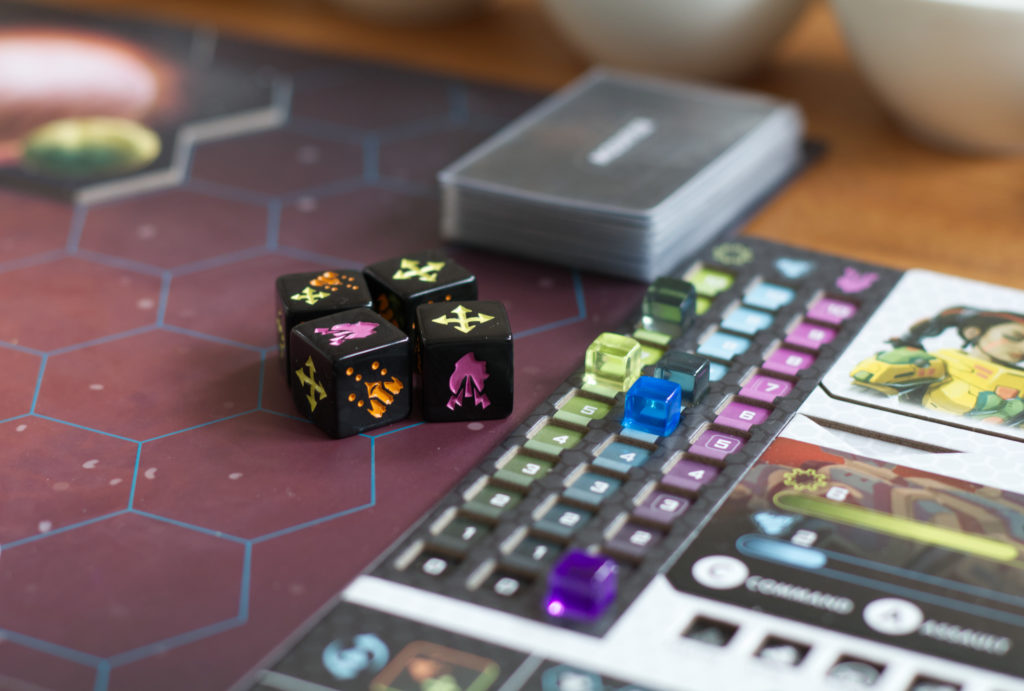
Combat is pleasantly simple. First, each player increases their shield strength by one and then roles their 4 action dice (showing move, fire, or stress symbols). Then the players use those dice to trigger various actions on their player board to move around or fire various weapons. Standard movement is surprisingly restricted, with only one rotate up to 120 degrees, two moves forward, and two curves. This puts extra significance on those engine upgrades to allow you to bank to the side or rush forward and flip around in one swoop. If you do actually fire on an enemy, the base strength of the weapon is then modified by drawing the top card of the pilot’s modifier deck. It consists of values between plus and minus 1 for the most part, but there is also a miss and a 2x in there. By successfully completing scenarios, the players will be able to optimise their pilot’s deck by either removing negative cards or adding positive ones. You can also improve your chances by attacking an enemy from behind, allowing the player to draw two modifier cards and choosing one of them.
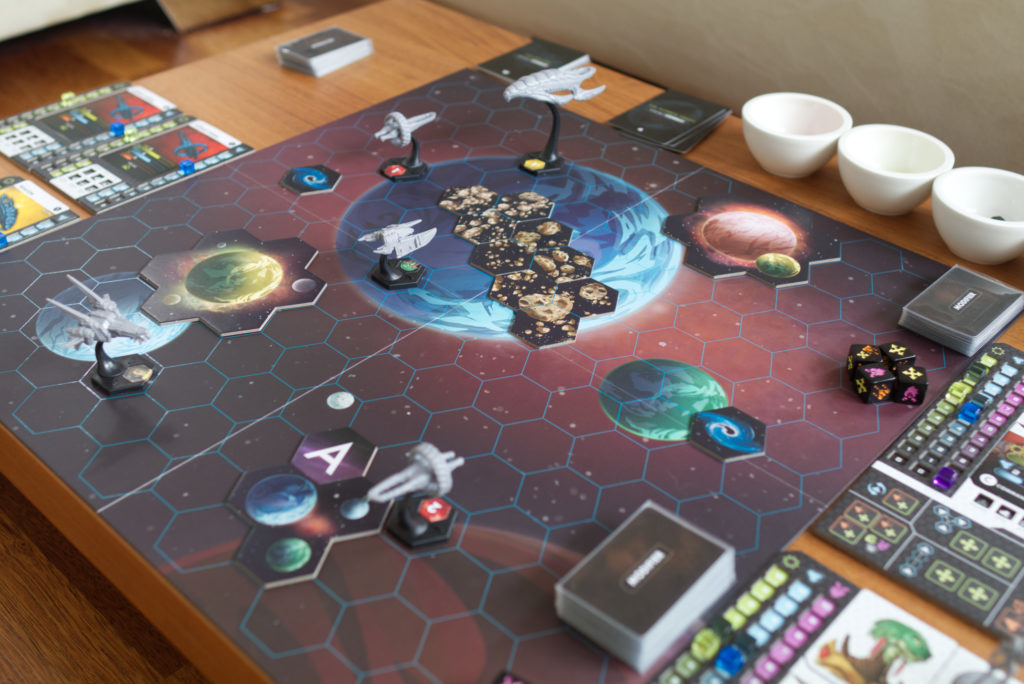
Things are spiced up by various temporary combat effects such as stealth, stun (cannot fire), slow (cannot move), radar jam, and so on. My favourite one is piercing where some weapons are able to penetrate shields and directly reduce an enemy’s hull value. The other major mechanism is stress. The stress symbol on a die can be used as a wild, but if you choose to use it, this increases the pilot’s stress level. When you reach 3 or 5 stress, an additional “miss” modifier is shuffled in your deck. Reach 7 or 10 stress, the pilot is “triggered” and depending on the number of trauma points the pilot has collected in previous missions, an increasing number of bad things happen to the pilot. Trauma doesn’t automatically reset but has to be dealt with in between combat by finding a location where it can be reduced in exchange for some money.
Once all players have moved, each type of enemy on the board moves based on the top card of their combat deck. Those cards show a sequence diagram of rotates, moves and fire symbols. Don’t expect too much intelligence here. All ships of a type use the same card and the movement rules fit on half a page of the rules and they sometimes flight right through astroid fields, damaging themselves in the process. The upside is that combat is rather fast paced and flows nicely. Role your dice, choose the actions from your player board, process enemies, next round. Since each player has a different set of upgrades, a nice bit of interaction between the players as well as between the players and enemies is created. The rules even encourage players to perform their combat actions in parallel with limited communication (e.g. “you take that one, I draw this one into the astroid field”).
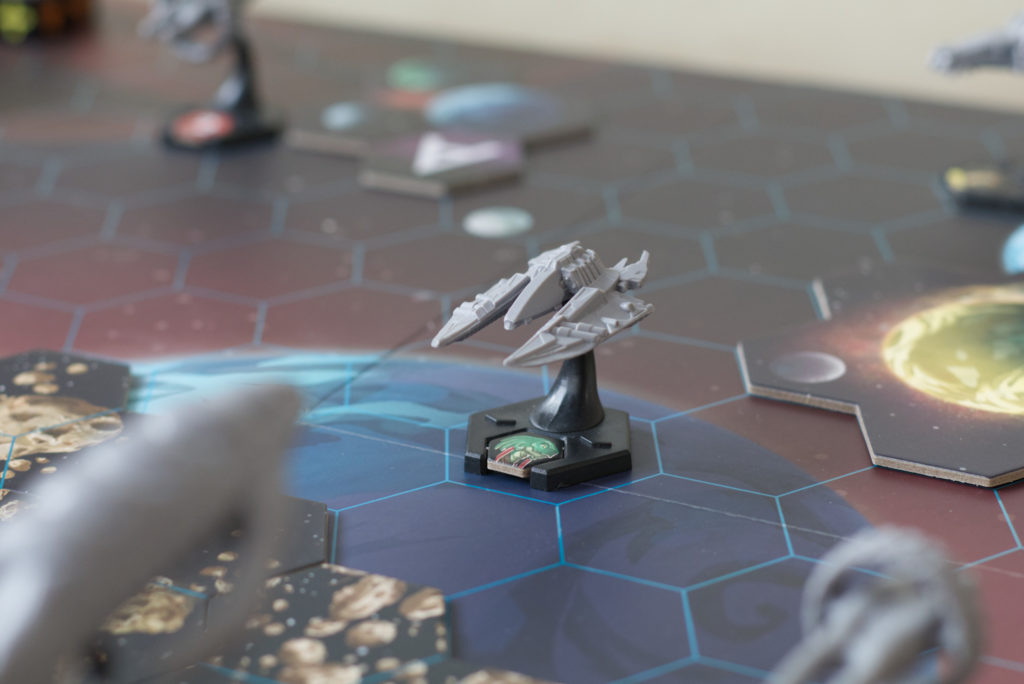
Most space combat scenarios either require you to destroy all enemies, last for a certain number of turns or protect something. So far, I haven’t seen as much variation as I would have hoped. The variety definitely comes from the mix of enemies more than the objectives you get.
World Exploration
In the course of the story, you’ll need to dock on a handful of planets and interact with the location or people therein. Each planet consists of a deck of square cards that you can explore by using your pilot’s miniature to walk around. On each card, there are a couple of possible actions, each marked with a reference number for the corresponding description in the scenario book. For most of them (including moving to another card), the players will have to perform a dice check. E.g. a location might be a test of strength and the player needs to role 3 attack symbols to succeed. The player first decides how many of their dice they want to “commit” and then rolls them. Add the base skills of the pilot (e.g. strength) and if the correct number of symbols is rolled, you succeed. Note that regardless of how many symbols you needed, the committed dice are all set aside until next round. So each round, players use their 4 dice to perform actions, run out of dice, and then commence a new round.
To make things a little more interesting, the shield track on your player board is used as the “energy” of the pilot. Each round it ticks down a notch and if you have none left, stress increases. If stress is already at 10, health decreases until the pilot goes unconscious. You also get stress if you role the stress symbol during a skill check. So energy acts sort of like a pressure timer, which sometimes works better and sometimes works less well as a mechanism. We’ll get to that later on.
World exploration is rather simple compared to my only other reference Sleeping Gods. A number of locations are just there to give you a small bonus or tell you about the world. Others will tell you to scout (e.g. go to a certain place during space exploration) to continue the narrative there. There is little branching and only a few choices to make here.
Solo & Player Count
A quick word about player count. For the most part, the game just scales the number of enemies or hull strength of a big baddy with the number of players. As a result, playing solo will get you less enemies on the board than playing with four players. While there is a pure solo mode, I rather opted to play with two pilots to have two different player ships and a bit more enemy ships. I’d strongly recommend any solo player to do the same.
Playing with another human was fun and I liked the idea of performing combat actions in parallel. In the end, the difference between playing solo two-handed and playing 2 player was more that of a shared experience rather than any mechanical changes.
Ships of Akarios and Playmat
While the base game comes with cardboard standees, my guess is that most backers opted to get the enemy miniatures as well. I really like them. They are of good quality and the ship design is cool. Normal ships are on small plastic stands where bigger ships are placed on higher stands, giving them a nice looming quality. The toy factor definitely increases the level of enjoyment I get out of Stars of Akarios. A minor gripe of mine is that the scale doesn’t really make sense as the players’ fighter ships are disproportionally large compared to the enemy ships. So it gives the impression of more of a tactical ops map of space rather than actual ships flying around.
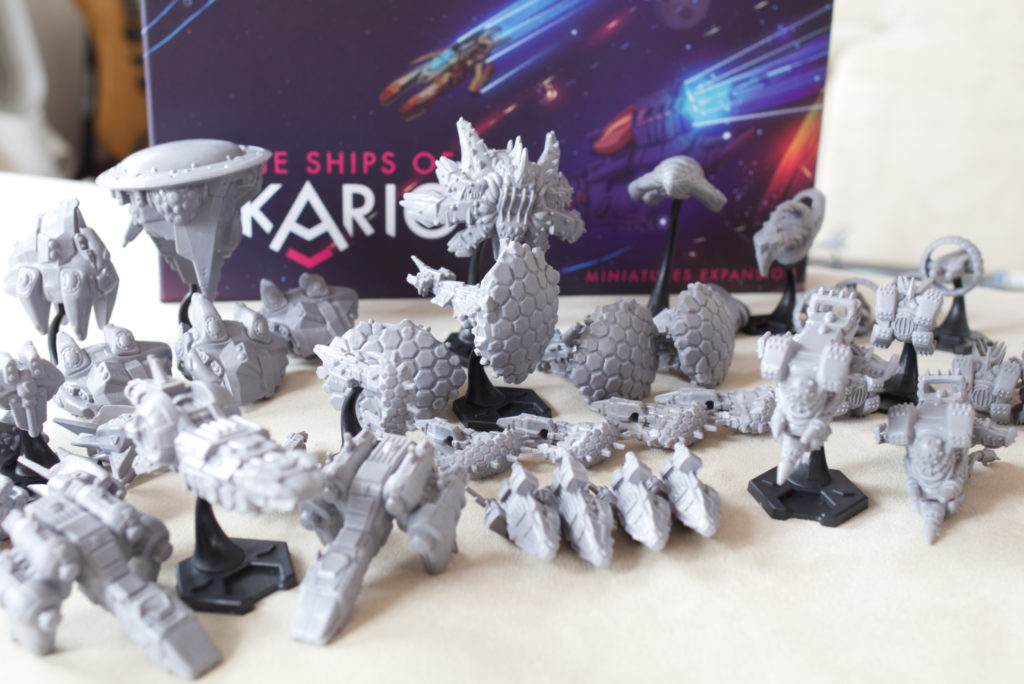
Speaking of which, I actually liked the board design. At first I was turned off by the idea of having large planets printed on the board mixed with cardboard elements layered on top of them. However, in practice it really has a nice presence and if you don’t like it, there is always the more bland version on the backside of the board. I didn’t get the optional playmat and don’t think you have to lose any sleep if you didn’t either. The board has a nice glossy finish and overall I like the look with the minis flying over the board.
Conclusion
Getting to a concise conclusion here is difficult. Do I enjoy playing it? Yes. Is Stars of Akarios – so far – what I had hoped for? No. I can best describe it in that I was really excited during the prologue, flying my first battles, discovering how world exploration works, and so on. I got Stars of Akarios set up on a side table and squeezed in one or two scenarios each day because I wanted to further dive into the game. The short playtime of each individual battle made this a nice, snackable evening experience for me. However, at the end of Act 1 I find myself still enjoying the space combat but tuning out when it comes to the story and role playing elements. The latter is an aspect that is worth diving into a bit.
For me, Stars of Akarios is in a weird limbo state of what it wants to achieve. For a catchy space fighting game, the story, space and world exploration are sort of getting in the way. This becomes apparent in Act 1 when you visit larger planets. It reminded me of playing Assassin’s Creed the video game and coming into a new town: I was struggling to get a feel if the game wants me to go straight along the main story line and all the other things are just optional avenues for me to take – or – if I need to grind it all to level up or find some essential thing I would need later. Most of the time you don’t even have a clue what lurks behind that random number on the map and in multiple cases the number referred to something that actually wasn’t on the card but on an adjacent card I hadn’t explored yet. I also had multiple occasions where doing an event actually assumed I had done something else before on the map so the story description didn’t make any logical sense or referred to characters I hadn’t actually met. All of this threw me out of the story and kept me asking what the heck I was doing there. The answer: most likely just looking for the next space combat.
Talking about the story: It unfortunately hasn’t really hooked me yet. I liked the prologue and general setup, but playing through Act 1, none of the characters are memorable to me. What I do like is the general sense of being thrown into something that is way over my head. For example, at one point in the story you have to make a choice that very obviously will have large consequences. There isn’t really any grounds on making that decision and in that case, this is great! If I would be in that situation, I also would have no clue what to do. When I hit that point and the game asked me what I wanted to do, I actually stuck at it for 15 minutes and pondered the potential consequences of what my decision might or might not mean. I had a similar effect also with other, smaller choices I had to do during the campaign. The impact on actual game play will probably not be as severe as you might think, but being put into that headspace is really cool.
Another cool element is that failure is actually an option. The penalty for not completing a mission usually is just reduced rewards and additional trauma which you can compensate later on. But you cannot lose the game per se and 1-2 scenarios actually felt like they are unwinnable (unless you break the game by using mechanisms that are allowed but feel completely unrealistic) to strengthen the overall experience. It feels better to be this struggling crew of newbies instead of the prodigy child that just wins everything.
Unfortunately, game play and experience seem to step on each other’s toes here. The more the story tries to use re-occuring characters and locations to introduce realism, the more mechanical it is to travel through already revealed parts of space or a planet because nothing new happens there once explored. What could have been a short thematic description between two space battles becomes ten minutes of admin work because you have to move the Sparrow, refuel it, walk along the planet, talk to someone, go back, until you finally get the number where the next battle is. So while space exploration and world exploration are great to give you a sense of scale, it quickly becomes one of uneventful busywork. That’s a shame because the very first world exploration you do is actually done well: it runs on a timer and you feel the struggle to quickly get in, do what you need and get out. The planet in Act 1 does a few things that completely render the energy (=timer) and dice-roling-movement mechanisms inert. It’s like you are in an action movie and suddenly someone stepped on the breaks. I really hope Act 2 will get back to form.
Space exploration seems flawed as well. What at first looks like a vast map of options for you to choose from turns out to just be something to introduce travel time between missions. The vast majority of locations can only be explored when the story has told you explicitly to go there and the few optional side missions are weird because you have no idea how dangerous they will be.
With that out of the way, let’s focus on space combat. As I said before, I really enjoy the quick pace and ease of play once you get into it. Initially, the combat effects are a bit of a headache. There are a lot of different ones and you’ll find yourself referring back to that page in the rules a lot. What’s a “stun” again? What does the radar jam do? Took me a bit to really internalise the effects. What’s also tricky is that you mark them on the player/enemy boards and have to remember to remove the effects at the correct time. For example, the stealth effect stays until a) the ship fires or b) the end of the next round. So you’re in a round and wonder: did I activate my cloak this turn or the last one, or the one before that? The core mechanism of you having limited movement options and the enemies sometimes doing stupid moves surprisingly works for me if I establish a bit of head canon. My weapon may need a straight orientation towards the enemy and that may seem surprisingly difficult, but I imagine in space getting someone into that narrow cone of direction would actually be tricky.
One thing me and my co-player noted is that the randomness and the high level of rotation the enemies do prevent any advanced positioning. Yes, you get a bonus when you attack from behind, but it’s difficult to out-maneuver an opponent that can rotate twice as much as you. The general strategy seems to be a) isolate enemy ships and b) hit the big ones with piercing weapons (ignoring their shield) to get rid of them before they can fire back. I had hoped for a bit more nuance somehow. Maybe different weapons will allow for different strategies (e.g. stun the opponents so they cannot fire) but I find myself doing the same thing more or less all the time. Recently, I try to lure the enemies into certain positions before striking but not sure if that really makes a difference.
What is also odd is that a player can – at will – flip weapon/engine upgrades to completely prevent damage from one shot. This seems like a mechanism to counteract the randomness in lucky shots from the enemy AIs rather than anything thematic. It would have been much cooler if with every shot that hits your hull, there would be a die roll to determine if you lose a random upgrade instead of getting hull damage. It gets even stranger with the option to sacrifice a players ship ability to prevent damage from the Sparrow. In some scenarios, you must protect the sparrow from being destroyed and having a fighter that’s far away switch off thrusters to absorb the damage is a bit jarring.
So to sum it up, I’m a bit torn. On the one hand I’m all in for what Stars of Akarios is trying to achieve but on the other hand I’m not sure it manages to do so. The production is lovely and there is a smorgasbord of upgrades, co-pilots, tech and other things you can unlock, not to mention additional player ships and pilots. But there are so many minor oddities in the rules and story that can spoil the otherwise great experience. We’ll see. I’ll play a few more scenarios and then figure out if I abort the campaign or continue onwards. Definite recommendation to try a couple of scenarios of Stars of Akarios, you’ll have a great time! I’m just not sure if I can recommend sticking around for a whole campaign yet. Remember, this has only been Prologue and Act 1, I’ll try to update this as I dig deeper. All in all though, very impressive game!
Update July 17, 2022: I’ve tightened up the conclusion part a bit for better readability and removed anything that could be perceived as spoilerish.
Update July 27, 2022: So I’ve completed Act 2 and I’m afraid that’s it for me and Stars of Akarios … which feels weird because I really liked Act 2: the pacing was good, the space exploration was nicely integrated into the story and didn’t feel like busy work, the world exploration was quick and to the point (but there was a lot to explore if you wanted to), and most of all: there was way more variety in space missions than I had expected. I had multiple times where I read the special rules of a scenario and was like “hey, this is neat!”. For me, this is where Stars of Akarios really shines!
A lot of combat in Act 1 only changed in the combination of enemies that were thrown at you and where planets or asteroids were put on the map. Unfortunately, the type of enemies or number thereof didn’t fundamentally change my playing style, choice of weapon or strategy. So one battle quickly felt like a previous one. This was mixed with some scenarios which I managed to complete within a few turns (I believe one took only 2 turns) and other cases where unfortunately lucky draws for my enemies meant I head a really, really hard time. In contrast, Act 2 has lots of little sprinkles: things on the board have different effects than before, the goal of what you try to do is completely different, basic mechanisms you use since scenario 001 are changed, and so on. I try to be vague here for those that don’t want to be spoiled. I’ve also read through Act 3 but I won’t go into it here for the same reasons.
So why won’t I continue to play? I noticed towards the end of Act 2 that things started repeating again and I skipped whole scenarios. First, I was just quickly looking at the next scenario out of curiosity if it would stay the same or do something different again. But then I read on and on and realised I had no interest in setting those missions up. I could play them out in my head and found nothing new that would give me a different experience. As enjoyable as the space combat is, it is just too chaotic and light to stand on its own and needs those changes in scenario rules to stay entertaining. Sure, I’ve acquired new tech, co-pilots and weapons. But they aren’t enough reason for me to play yet another scenario.
The storytelling unfortunately still remains a weak point of Stars of Akarios. My highlight (in a negative sense) was when something dramatic happened to the characters which should leave everyone devastated and within a few sentences the characters acted cheerful as if nothing had happened. There are good ideas in there and plot turns I hadn’t anticipated, which makes it even more a shame that the execution is so flawed. Maybe the small amount of text between missions is just not enough room to tell a story on the scope that Stars of Akarios has. I found myself wondering multiple times what this game could be like if someone in the community would try to write a longer narrative with more fleshed out characters and time to let dramatic moments sink in… speaking of story, an obvious question is: how is the replayability? I would say if you play through the campaign once, you’re satisfied and there is little reason to do another campaign. Your choices lead to different scenarios and rewards, but ultimately the story – as far as I can tell – is a mostly linear experience with different paths converging rather quickly for the most part.
That being said, I have to say I got my money’s worth out of this game! If my count is right, I’ve played roughly 30 combat scenarios plus all the reading time and purchasing upgrades, making story choices, etc. I really like the production and what it brings to the playing experience. The trays, the tons of upgrades, the board design, and especially the Ships of Akarios! The rules are something to politely gloss over here, but all in all a great package. I think the majority of players will have a good time with Stars of Akarios, there is a lot to like. The question is only how long that feeling will stay with you: a couple of scenarios, a single Act, or even more? Hopefully these first (and second) impressions will help Stars of Akarios find its right audience and tempt you the reader to give it a try and find out!
